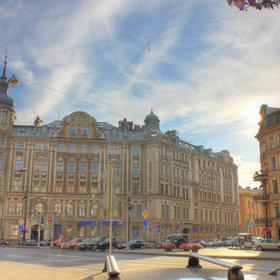Once upon a time, the street was called Kamennoostrovskaya road. At that time, it was possible to get to Kamenny Ostrov on Bolshoi Avenue through the Tuchkov bridge. Kamennoostrovskaya Road received the status of the avenue in 1802. The construction of the bridge connecting Kamennoostrovsky Avenue with the center led to the rapid development of the region. The avenue becomes the busiest street in the city.
In 1903, with the construction of the Trinity Bridge, the area began to have good transport accessibility. At this time, beautiful houses were built here according to the projects of famous architects, parks were laid, sidewalks were paved, water supply and sewage were laid. Gradually, the area becomes prestigious and attractive for the influential and wealthy people of that time.
The structures on the avenue are decorated with numerous corner turrets crowned with spiers and domes. Decorative elements in the form of balcony bars, gates and fences emphasize the originality of one of the most beautiful city avenues. Famous architects worked on the construction of unique houses: Benoit, Lansere, Lindvall, Schuko.

Kamennoostrovsky Avenue was formed in stages. Initially, the highway was built from separate sections. The streets in St. Petersburg, including the Kamennoostrovskaya road, were first shown on a map of the city in 1738. It reflects the first name of the avenue - Bolshaya Ruzheinaya street. In the period from 1771 to 1799, part of the future avenue became known as the road to Kamenny Island. Since 1822, the name of the street — Kamennoostrovsky Prospect — began to appear on the map of St. Petersburg, which did not refer to the entire street, but only to its part near Kamenny Island. Since 1867, the entire highway became known as the avenue. The plots that were located along the avenue belonged to merchants, tradesmen and retired officers. In the St. Petersburg press, Kamennoostrovsky Prospect received the name "Eliseevsky Fields of St. Petersburg. He was even called a small part of Paris. At the end of the XIX century, the avenue was gradually built up with stone buildings. In 1870, a horse was built.

Kamennoostrovsky Avenue is built up with tasks performed in the most diverse architectural styles: classicism, modern, neoclassicism. Since 1918, most of the avenue to the Malaya Nevka River was called the Red Zory Street.
After the death of S.M. Kirov, who lived on the street. Red dawns in the house number 26, in 1934 the avenue became Kirovsky. In 1935, a large-scale reconstruction was carried out - obsolete buildings were demolished, public gardens were created on the embankment. In October 1991, the avenue was returned to its historical name.
Kamennoostrovsky pr. And today is one of the most beautiful city highways. This avenue is distinguished by its beautiful and majestic views. There are Vyazemsky and Lopukhinsky gardens, as well as the Church of the Nativity with a large park with access to Bolshaya Nevka.
The history of the famous highway is very closely connected with the stories of celebrities from different cultural eras. Here lived S.M. Kirov, S.Yu. Witte, artist A.I. Raikin, the world famous ballerina Kshesinskaya. The most remarkable building on the avenue is the House with towers. Earlier in this house there was a cinema, later a Leningrad television studio and the Experience Theater. Since 1996, this house houses the Theater of Russian Entrepreneurs named after Andrei Mironov.